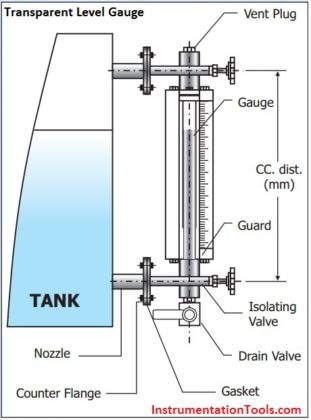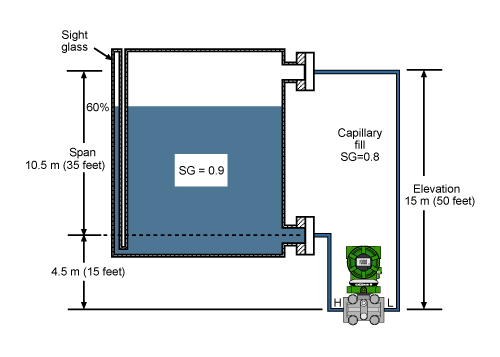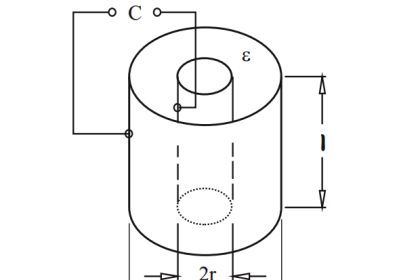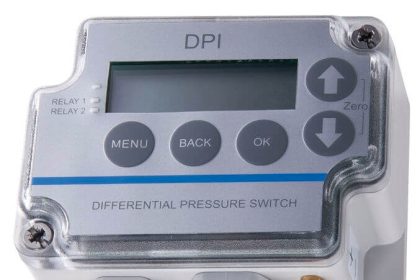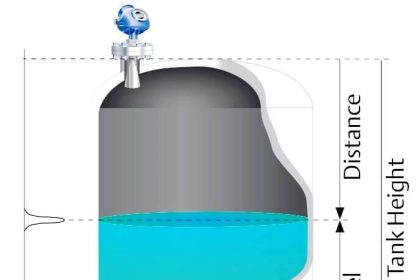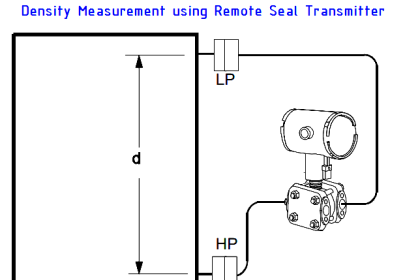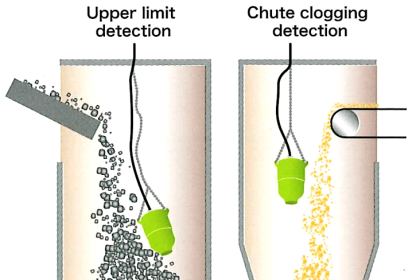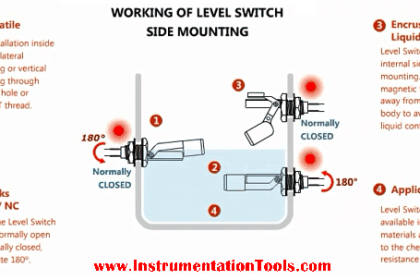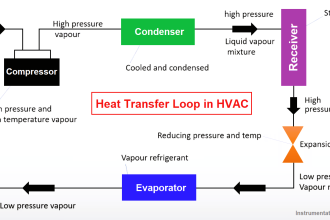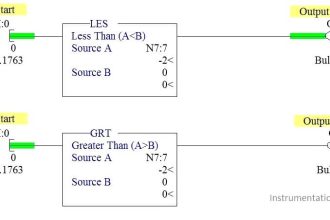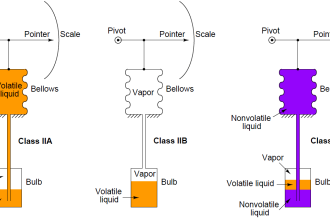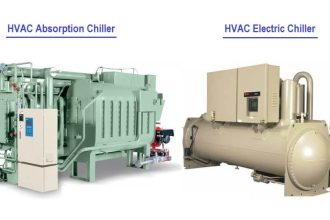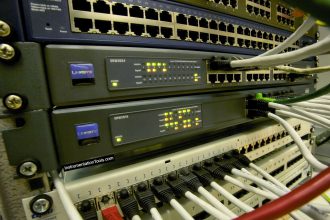Definition of Level Indicator
Level indicators are devices used in the measurement of level of fluids at various industrial applications. These devices are used to determine the level of liquid in tanks, drums. pressure vessels etc..
There are many level indicators to suit the needs of different applications. Normally, fluids are used in many forms in highly commercial industries. Without proper devices it will be very difficult to find the quantity and level of fluid stored. Also, in certain situations where the nature of fluid is dangerous or the place in which the liquid is stored is of such a nature that it is manually impossible to find the level, then the level indicators are of utmost importance.
Depending on the type of application used, the type of level indicator should be selected. For example, in the process industry, tubular level indicators are used for better visual liquid level indication. If it is for non-contact type level measurement, then radar type indicators or ultrasonic type indicators are to be used.
Types of Level Indicators
There are many different types of level indicators, each with its own application.
- Transparent level indicators are highly useful in chemical industries and petrochemical fertilizers. As the fluid is stored in high pressure and high temperature, the transparent level indicator is very useful to find the fluid level.
- Reflex level indicators are for applications that involve high temperature, high pressure and use of corrosive fluids. The colorless fluid used in this apparatus gives better clarity to level indication.
- Magnetic level indicators are red followers that need magnetic level indicators. Cylindrical floats and powerful magnets are used to find the level of the fluid. The float movement is followed by magnetic capsules, and thus, the level in indicated. This type of indicator has good visibility and is absolutely safe to use as it contains non-fragile metal chamber.
Some other level indicators for reference are tubular level indicators, float and board level indicators, sight flow indicators, window type sight flow indicators, manometers, and bi-color indicators. Some of the level indicators are provided with various features, such as a built-in controller, continuous output measurement, and adjustable alarm switches.
Transparent Level Gauge
Working principle
Apart from glass tube level gauges, transparent level gauges are always fitted with two plate transparent glasses between which the fluid is contained. The fluid level is indicated as the result of the different transparency of the two media and in some cases (for water steam), by conveying upwards on to the surface of separation (between liquid and gaseous substances) a source of light located at the back of the gauge, the rays of which are totally reflected down to the observer.
- the use of mica shields or Polytrifluorochloroethylene shields to protect the glass from the corrosive action of the process fluid.
- the observation of interface.
- the observation of the liquid colour.
This instrument consists of a metal body, machined to have an internal chamber and one or more front windows (on each side of the gauge). On each window a special high resistance plate transparent glass is applied with sealing joint and metal cover plate hold by bolts and nuts.The chamber is connected to vessel with cross fittings and flanged, threaded or welded ends. Usually, between the instrument and its connecting ends, valves are fitted to consent shut-off piping and to disassemble the level gauge without to empty the vessel. Drain valves can also be fitted to cross fittings device.
To avoid leakage in case of glass breakage, safety ball-check device can be provided in cross-fittings or shut-off valves. This kind of indicator is suitable for water/steam. To protect glass surfaces from corrosive action of the process fluid, Transparent Level Gauges can be fitted with Mica shields or Polytrifluorochloroethilene shields. This kind of indicator is suitable for liquids colorless and very fluid.
Reflex Level Gauge
The different brightness in the two zones is obtained as explained below:
Liquid zone
This zone appears quite dark when the gauge is in operation and lighted as above said.Given the construction, most of the environmental light rays incident on the external face of the glass are quite perpendicular to said face and, therefore, not deviated by the glass. These rays reach the glass/liquid interface with an inclination of approx. 45°. The critical angle glass/liquid is always superior to 45°. Therefore the rays incident within the critical angle (practically the totality) are refracted within the liquid and, since the internal walls of the gauge chamber are not reflecting, the rays cannot be seen from the outside. In fact the zone will appear dark, nearly black, to the observer.
Gas/vapor zone
This zone appears almost silver bright to the observer.As for the liquid zone, the light rays reach the glass/gas-vapor interface with an angle around 45°. Since this angle is greater than glass/gas-vapor critical angle, the rays are not refracted , but totally reflected making 90° turn, thus reaching the nearest glass/gas-vapor interface again with angle of 45°. For same reason they will be reflected and turned by 90° towards the observer, to whom the zone will appear silver bright.
Applications
Reflex level gauges cannot be used in certain cases as for example:
- when the separation level between two liquids has to be read (interface).
- when besides the level indication, the observation of the liquid colour is required.
- when the process fluid is high-pressure water steam, since in this case the glass must be protected from the solvent action of the boiler water by using mica shields.
- when the process fluid is such that can corrode the glass (e.g. high temperature alkaline solutions or hydrofluoric acid), since ica shields or Polytrifluorochloroethylene shields must be used to protect the glass.
Magnetic Level Gauge
The operation of the magnetic level gauge is based on some elementary physical principles:
- The principle whereby the liquid in communicating vessels is always at the same level
- Archimede’s principle according to which a body immersed in a liquid receives a buoyancy equal to the weight of displaced liquid
- The principle of attraction between North and South poles of two permanent magnets and that of repulsion between like poles.
This principle has two applications in the magnetic level gauge:
- first between the magnet in the chamber float and every single magnet of the indicating scale
- second between the magnets of the indicating scale
Applications
The application range is very wide and includes all the situations where the fluids are:
- at high pressure, at low or high temperature
- at low pressure, at low or high temperature
- chemically aggressive
- pollutant to environment
- noxious or poisonous for people health
- inflammable or explosive
- with identical optical characteristics of the superimposed phases (interface)
Design
The magnetic level gauge consists of:
- a vertical chamber consisting of a tube of suitable diameter and thickness containing a float wherein a permanent magnet is placed exactly on the liquid level line
- two horizontal stub pipes for connection to the vessel containing the liquid of which we wish to know the level
- two stop valves (recommended, but not mandatory) one on each stub pipe, to isolate the level gauge
- an indicating scale, outside the vertical chamber, consisting of a case of non-magnetic material with transparent front face containing a set of small permanent magnets enclosed in small cylinders which can rotate on their horizontal axis.
These cylinders show an external surface having two different colours. According to the orientation of each magnet (due to the action of the magnet in the float) each cylinder will show externally half of its surface of one colour or the other.
The indicating scale will be of one colour (e.g. white) over the chamber area taken up by gas, vapour or steam phase contrasting with the other colour (e.g. red) over the chamber area taken up by liquid phase. Alarm system for damaged float. The three bottom cylinders of the indicating scale are placed lower than the bottom connection of the magnetic level gauge. They are used for control of float efficiency. With float damaged and its consequent sinking in the liquid, these three cylinders show the yellow surfaces.These level gauges are very suitable for interface reading: the level gauge float has only to sink in the liquid having lower specific gravity and to float on the liquid having higher specific gravity.
Reflex Level Gauge vs. Transparent Level Gauge
A reflex level gauge is a single piece of glass that is mounted on one side of the vessel. It is flat on the outside, with a series of prisms on the inside that face the liquid inside the vessel. The reflex level gauge uses the prism glass to provide an accurate measurement of the liquid level inside the vessel; when light strikes the glass on the part of the glass that contains no liquid, the prism will reflect the light directly out of the gauge.
This “dry” area of the gauge will display a silver color. Then, when light strikes the portion of the glass covered by liquid, the light is reflected from the back of the chamber. That “wet” part of the gauge will display the liquid in black. The two contrasting colors will produce a clear line of delineation, which makes it possible for the measurement to be viewed and estimated from several yards away.
There are three pressure series choices for a reflex level gauge: low, medium and high. The lowest temperature that reflex gauges can accommodate is -20 degrees F.
A transparent level gauge is a different design and composition. A non-tubular transparent level gauge will be fitted with two plate transparent glasses; the liquid is contained between the two glasses. Then, the liquid level is indicated by the different transparency of the two media. The exception to this is when steam is being measured, which would convey upwards on the surface of separation between the liquid and the vapor.
There is a source of light located at the back of the transparent level gauge, the rays of which are reflected down to the observer so that a measurement can be estimated or read. A transparent level gauge is appropriate for almost all installations, and it permits the use of Mica shields for excellent glass protection (if the environment is corrosive, then Kel-F shields should be used instead).
